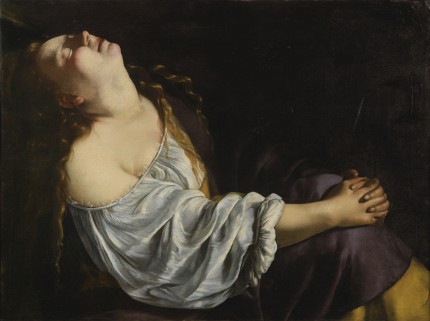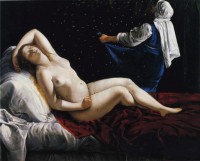 A rediscovered painting by Baroque master Artemisia Gentileschi sold for a world record €865,500 ($1,175,211) at a Sotheby’s auction in Paris on Thursday. The final price including buyer’s premium was far in excess of the pre-sale estimate of €200,000-300,000 ($271,568-407,352), driven up by seven bidders competing against each other.
A rediscovered painting by Baroque master Artemisia Gentileschi sold for a world record €865,500 ($1,175,211) at a Sotheby’s auction in Paris on Thursday. The final price including buyer’s premium was far in excess of the pre-sale estimate of €200,000-300,000 ($271,568-407,352), driven up by seven bidders competing against each other.
The previous auction record for a painting by Artemisia Gentileschi was £419,500 (about $715,000 at today’s exchange rate) set at 1998 Sotheby’s sale in London. It was the same Self-Portrait as a Lute Player that failed to sell at auction due to an overly-optimistic reserve in the millions of dollars last January. The Wadsworth Atheneum in Hartford acquired it in a private sale for an undisclosed sum in March.
Mary Magdalene in Ecstasy was thought lost, its existence only known from an early 20th century black and white photograph in the library of an Italian art dealer. Sotheby’s experts rediscovered it in a private collection in the south of France where it had been secreted away for 80 years. The old picture is thought to have been taken when the painting was acquired by the family of the current seller for their collection.
It’s no wonder that Mary Magdalene was subject to a bidding war. It is a particularly striking example of Artemisia’s Caravaggio-influenced play of light and dark. A large canvas at 32 by 41 1/3 inches, the piece depicts the Magdalene is the throes of religious ecstasy. The conventional wisdom is that it was painted between 1613 and 1620, the period during which Gentileschi became a highly sought after and respected artist in Florence. Some scholars believe it’s an even earlier work because they see her father’s influence in the color palette while her Florentine work saw her move away from that and develop her own signature style. Her Florentine period also featured more luxurious elements, while this painting is downright Spartan. Sotheby’s Old Masters experts think she painted it shortly after the devastating rape trial in 1611 when she was still in Rome. They believe she may even have used herself as a model, since she wouldn’t have had a great deal of access to paid models as a young woman artist still in her teens.
 The abandoned, blissful pose and the way the figure fills the frame is unusual. Artemisia’s father Orazio set his subjects farther back. This composition is all Artemisia, an early glimpse into her burgeoning creative vision. The religious theme illustrated by a figure bathed in a single strong beam of divine light was popular at the time (Caravaggio was a master of the form) but Artemisia’s treatment — the tight framing, Mary pictured as a regular woman without overtly religious iconography, the sheer ecstasy — takes a highly personal approach to the subject. Compare it to two other ecstatic women from her oeuvre, Cleopatra at the moment of her death and Danaë at the moment of her impregnation by Zeus as a shower of gold. Magdalene seems so much more naturalistic and unbridled rather than posed and conventional.
The abandoned, blissful pose and the way the figure fills the frame is unusual. Artemisia’s father Orazio set his subjects farther back. This composition is all Artemisia, an early glimpse into her burgeoning creative vision. The religious theme illustrated by a figure bathed in a single strong beam of divine light was popular at the time (Caravaggio was a master of the form) but Artemisia’s treatment — the tight framing, Mary pictured as a regular woman without overtly religious iconography, the sheer ecstasy — takes a highly personal approach to the subject. Compare it to two other ecstatic women from her oeuvre, Cleopatra at the moment of her death and Danaë at the moment of her impregnation by Zeus as a shower of gold. Magdalene seems so much more naturalistic and unbridled rather than posed and conventional.
She is one of my favourite artists. Years ago when I was living in the US Midwest, I used to sit in the gallery at the Columbus Museum of Art studying her painting, Bathsheba. It fascinated me as I could see the shadows of other forms beneath the surface painting where she changed her mind to create a different image.
Bathsheba
😆
I have a oil on panel painting of Mary magdelene playing the lute. What do you think it’s worth
Has anyone considered that this might be stolen art? “Discovered” 80 years ago, that would be 1934, in a “collection” in the south of France? Where was it before that? Why hasn’t anyone asked? I saw it at the Sotheby auction. Will we ever see it again?